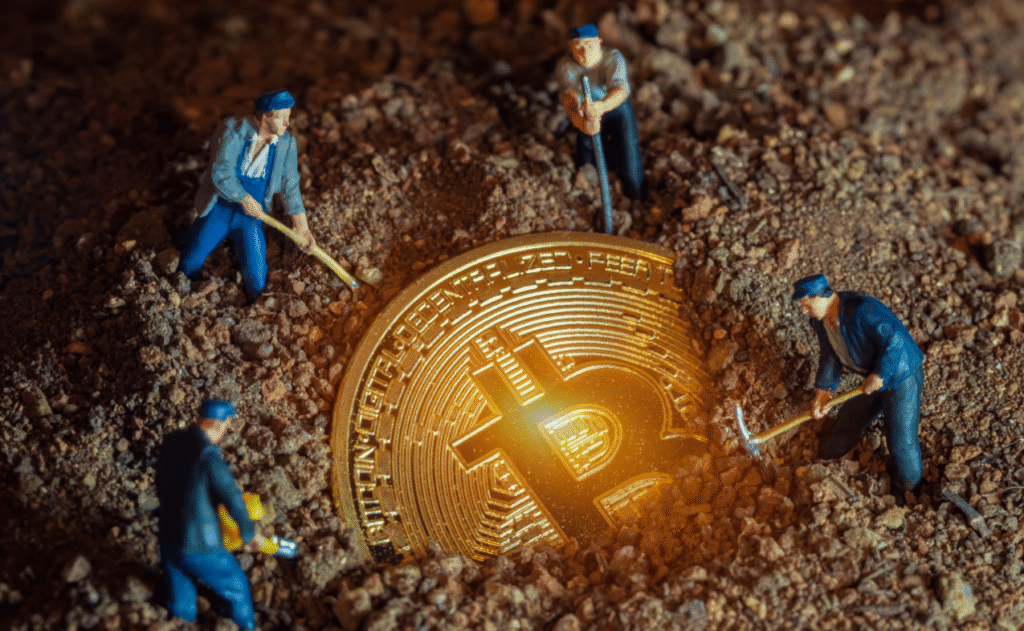Is Mining BTC Profitable?: The Guide

Bitcoin mining has evolved dramatically since its early days, when anyone could mine coins using a simple laptop. Now, the question many ask is: “Is mining BTC profitable in 2025?” The answer depends on various factors like energy prices, hardware efficiency, Bitcoin’s market value, and mining difficulty.
Mining BTC isn’t just about creating new coins — it’s about validating transactions and maintaining the decentralized nature of the blockchain. This process consumes electricity and computing power, making profitability a delicate balance between cost and reward.
Let’s explore how Bitcoin mining works and what influences its profitability today.
What Is Bitcoin Mining?

Bitcoin mining is the process by which transactions are verified and added to the blockchain ledger. Miners compete to solve complex mathematical puzzles using specialized computers, and the first to solve one receives a block reward — currently 3.125 BTC after the 2024 halving event.
This reward, along with transaction fees, incentivizes miners to secure the network. However, as rewards decrease over time, efficiency becomes more crucial for profitability.
How is Mining BTC Profitable: The Basics Explained

Mining involves combining computational power (hashrate) with software that runs algorithms to find valid hashes. Once a miner finds a valid block hash, it is broadcast to the network and added to the blockchain. The miner receives the reward directly in their BTC wallet.
Key components include:
- Mining hardware (ASICs or GPUs)
- Mining software
- A mining pool or solo mining setup
- Electricity source and cooling system
The Economics Behind BTC Mining

Bitcoin mining profitability is influenced by multiple economic variables.
Mining Rewards and the Halving Effect
Bitcoin halving occurs every four years, cutting block rewards in half. The last halving in 2024 reduced rewards from 6.25 BTC to 3.125 BTC per block. This impacts miner revenue directly, especially if Bitcoin’s price doesn’t rise proportionally.
Cost Factors: Electricity, Hardware, and Maintenance
Electricity is the largest expense. On average, mining 1 BTC consumes between 350,000 to 450,000 kWh, depending on efficiency. Hardware prices range from $1,000 to $10,000, and cooling systems add extra costs.
BTC Market Prices and Mining Difficulty
Mining difficulty adjusts roughly every two weeks to maintain block production at 10 minutes. If many miners join the network, difficulty rises, reducing the odds of earning rewards.
Profitability Analysis of BTC Mining in 2025
How Much Does It Cost to Mine 1 Bitcoin in 2025?
As of 2025, the cost of mining one BTC ranges between $35,000 and $55,000, depending on power rates and hardware efficiency.
Current Average Mining Profit Margins
At a Bitcoin price of $65,000, miners with cheap electricity (<$0.06/kWh) can achieve a profit margin of 15–25%. However, miners in areas with higher electricity costs may struggle to break even.
Break-Even Analysis
The break-even point occurs when BTC price = total operational costs. If Bitcoin dips below this level, miners either shut down operations or wait for prices to recover.
The Role of Mining Hardware and Efficiency

ASIC Miners vs GPU Miners
ASICs (Application-Specific Integrated Circuits) dominate Bitcoin mining due to their efficiency. GPU mining, while flexible for other coins, is largely obsolete for BTC due to higher difficulty levels.
Top Bitcoin Mining Machines in 2025
Some of the most efficient ASICs in 2025 include:
| Miner Model | Hashrate | Power Consumption | Efficiency |
| Antminer S21 | 200 TH/s | 3500W | 17.5 J/TH |
| WhatsMiner M60 | 170 TH/s | 3420W | 20.1 J/TH |
| Avalon A1466 | 150 TH/s | 3100W | 20.6 J/TH |
Energy Efficiency and Hash Rate Optimization
Upgrading to energy-efficient miners can significantly reduce electricity costs and improve ROI. Many farms are relocating to regions with renewable energy sources.
Cloud Mining vs. Solo Mining vs. Pool Mining

The method you choose for Bitcoin mining has a significant impact on your overall profitability. Each approach has its advantages, risks, and ideal use cases.
Pros and Cons of Each Mining Model
| Type | Description | Pros | Cons |
| Solo Mining | You mine independently without joining a pool. | Full control; full rewards if successful. | High difficulty; inconsistent payouts; requires significant investment. |
| Pool Mining | Multiple miners combine their hash power to increase the chances of earning rewards. | Consistent payouts; shared effort. | Pool fees (1–3%); less control. |
| Cloud Mining | You rent mining power from a third-party provider. | No need for hardware or maintenance; easy start. | High risk of scams; low ROI; limited transparency. |
Is Cloud Mining Still Worth It in 2025?
Cloud mining was once an appealing entry point for beginners, but by 2025, profitability will be minimal due to high service fees and declining block rewards. Many cloud mining contracts no longer yield positive returns unless BTC prices surge. Always research providers thoroughly and avoid unrealistic “guaranteed profit” offers.
Environmental and Regulatory Factors
Green Mining: The Push Toward Renewable Energy
As concerns about Bitcoin’s environmental footprint grow, miners are increasingly adopting renewable energy sources, such as hydro, solar, and wind power. Countries such as Iceland, Canada, and El Salvador are leading with sustainable mining initiatives.
Renewable energy not only reduces carbon emissions but also cuts costs in the long run, improving miners’ margins.
Government Regulations Affecting BTC Miners
Different countries approach mining differently.
- China banned large-scale mining operations due to energy concerns.
- The U.S., Kazakhstan, and Russia host many miners thanks to cheap electricity.
- EU nations are introducing carbon reporting laws for miners.
Regulatory uncertainty remains one of the biggest challenges, as policy shifts can make mining operations unviable overnight.
Real-World Profit Scenarios
To better understand the answer to “Is mining BTC profitable?”, let’s look at real-world examples.
Case Study: Small-Scale Home Miner
- Hardware: Antminer S19 XP
- Electricity Cost: $0.07/kWh
- Hashrate: 140 TH/s
- Revenue: ~$22
- Power Cost: ~$10
- Profit: ~$12
Even at home, profitability is possible with cheap electricity and efficient cooling, but margins remain tight.
Case Study: Industrial-Scale Mining Farm
- Hardware: 500 units of Antminer S21
- Electricity Cost: $0.04/kWh (renewable source)
- Total Hashrate: 100 PH/s
- Monthly Profit: $250,000–$400,000
Large-scale miners benefit from economies of scale and bulk electricity discounts, allowing for sustainable profits even during bearish markets.
How to Calculate BTC Mining Profitability

Using Online Bitcoin Mining Calculators
You can use tools like:
- NiceHash Profitability Calculator
- CryptoCompare Mining Calculator
These platforms help estimate your expected earnings by inputting:
- Hashrate (from your miner)
- Power consumption
- Electricity cost
- Pool fees
- Current BTC price
Key Metrics to Watch
- Hashrate – Higher means more chances to mine a block.
- Power Cost – Directly affects ROI.
- Pool Fees – Usually 1–3% of your earnings.
- BTC Price Volatility – Even a 10% price change can shift profitability dramatically.
Conclusion: Is Bitcoin Mining Still Worth It in 2025?
So, is mining BTC profitable in 2025? The short answer: Yes, but it’s not for everyone.
If you have access to cheap, clean power, use efficient ASIC hardware, and join reliable mining pools, you can still generate healthy profits. However, rising difficulty and halving events continue to squeeze margins for casual miners.
FAQs: Common Questions About BTC Mining Profitability
1. Is mining BTC profitable in 2025?
Yes, but profitability depends heavily on your electricity cost, hardware efficiency, and BTC market price. Miners with access to cheap renewable energy can still earn consistent profits.
2. How long does it take to mine 1 Bitcoin?
In 2025, with an Antminer S21, it takes roughly 180–200 days on average, depending on network difficulty and pool participation.
3. What is the best Bitcoin miner in 2025?
The Antminer S21 and WhatsMiner M60 are currently the top performers, offering exceptional efficiency per watt.
4. Can I mine Bitcoin on my laptop?
No, it’s no longer feasible. Mining difficulty and competition make it impossible to profit using regular CPUs or GPUs.
5. What is the average ROI for BTC miners?
ROI varies widely but typically falls between 15–30% annually for efficient operations with low electricity rates.
6. Is mining BTC profitable in ever end?
Yes — when the final Bitcoin (the 21 millionth) is mined around 2140, block rewards will stop, and miners will earn solely from transaction fees.




